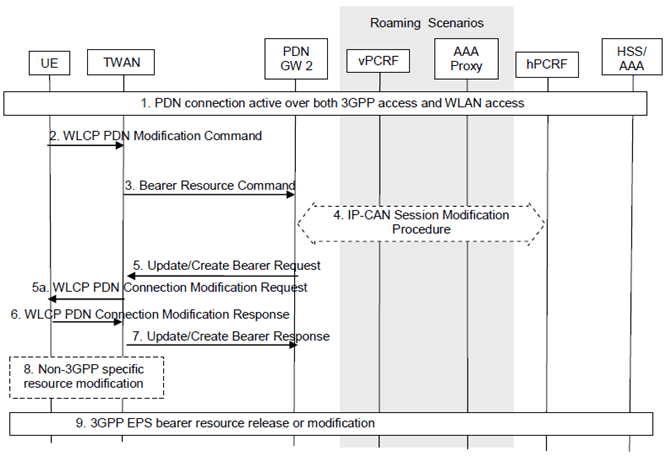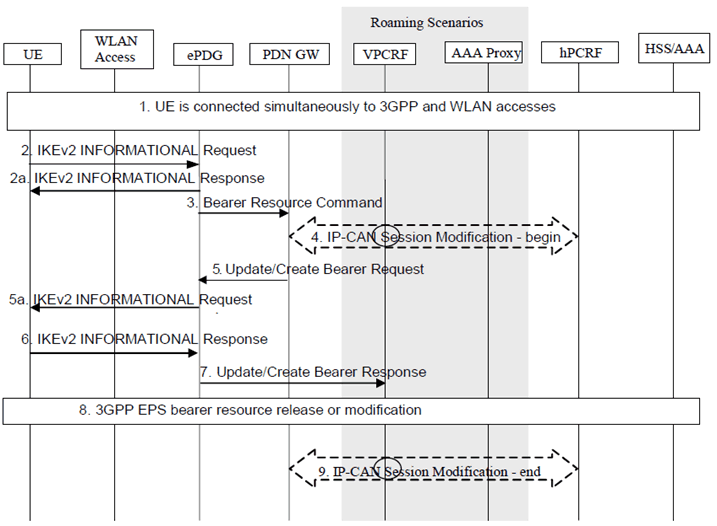Content for TS 23.161 Word version: 18.0.0
1…
5…
6…
6.2…
6.2.4
6.3…
6.3.2.2…
6.3.3…
6.3.3.2…
6.4…
6.4.2.2…
6.5…
6.5.2…
6.5.3…
6.6…
6.6.1.3…
6.6.2…
6.7…
6.7.2…
6.8…
6.3.3.2 Routing Rules signalled via Trusted WLAN access
6.3.3.3 Routing Rules signalled via Untrusted WLAN access
...
...
6.3.3.2 Routing Rules signalled via Trusted WLAN access p. 34
6.3.3.2.1 Single-connection mode p. 34
In single-connection mode, the UE sends the routing rules over 3GPP access as described in clause 6.3.3.1.
6.3.3.2.2 Multi-connection mode p. 34
In the following signalling flow, the UE provides new or updated routing rules with access type WLAN to the PDN GW via WLCP and GTPv2 procedures. The routing rule is sent via TWAN access in this case.

Figure 6.3.3.2.2-1: UE-initiated IP flow mobility within a PDN connection from 3GPP access to TWAN access using GTP
(⇒ copy of original 3GPP image)
(⇒ copy of original 3GPP image)
Step 1.
The PDN Connection is active simultaneously over 3GPP access and WLAN accesses.
Step 2.
The UE sends a WLCP PDN Modification Command message to the TWAN, which includes the Routing Rules requested by the UE.
Step 3.
The TWAN sends a Bearer Resource Command message to the PDN GW. The message includes the Routing Rules.
Step 4.
The PDN GW initiates the IP-CAN Session Modification Procedure with the PCRF. In this request, the PDN GW provides the Routing Rules to the PCRF. The PCRF analyses the received Routing Rules, makes a policy decision and provides new or updated PCC rules to the PDN GW with corresponding access type information. The PCRF may reject the IP flow mobility requests from UE. When the network rejects an IP flow mobility request, the network provides a cause value to the UE indicating why the request was rejected. The UE should be able to determine, based on the cause value provided with the rejection, how to handle the flow mapping, e.g. whether or not the request may be retried at a later stage.
Step 5.
The PDN GW sends to the TWAN an Update/Create Bearer Request which acknowledge of the Routing Rules. If bearer resources need to be established or modified due to the PCC rules received in step 4, the bearer operations may be performed in this step.
Step 5a.
The TWAN sends a WLCP PDN Connection Modification Request to the UE which acknowledge of the Routing Rules.
Step 6.
The UE sends a WLCP PDN Connection Modification Response to the TWAN.
Step 7.
The TWAN sends an Update/Create Bearer Response to the PDN GW.
Step 8.
A TWAN specific resource allocation/modification procedure may be executed in this step. The details of this step are out of the scope of 3GPP.
Step 9.
Appropriate 3GPP resource release / modification procedures are executed for the resources associated with the flows that were removed in the 3GPP access as described in TS 23.401.
6.3.3.3 Routing Rules signalled via Untrusted WLAN access p. 36
The UE can move one or more IP flow(s) from the 3GPP access to the WLAN access. The UE should update the routing rules via the WLAN access.

Figure 6.3.3.3-1: IP flow mobility within a PDN connection initiated over WLAN access
(⇒ copy of original 3GPP image)
(⇒ copy of original 3GPP image)
Step 1.
The UE is connected simultaneously to 3GPP and WLAN accesses and establishes multiple IP flows of the same PDN connection as described in clauses 6.2.
Step 2.
The UE sends the IKEv2 INFORMATIONAL request to the ePDG, which includes the updated routing rules requested by the UE.
Step 2a.
The ePDG sends an IKEv2 INFORMATIONAL Response message to the UE.
Step 3.
The ePDG sends a Bearer Resource Command message to the PDN GW. The message includes the updated routing rules. The ePDG includes the default EPS bearer ID (i.e. Linked Bearer ID) based on the mapping between the Security Association and the PDN connection. The ePDG sends the updated routing rules to the PDN GW.
Step 4.
The PDN GW initiates the IP-CAN Session Modification Procedure with the PCRF. In this request, the PDN GW provides the updated routing rules to the PCRF. The PCRF may reject the IP flow mobility requests from UE. When the network rejects an IP flow mobility request, the network provides a certain cause value to the UE indicating why the request was rejected. The UE should be able to determine, based on the cause value provided with the rejection, how to handle the flow mapping, e.g. whether or not the request may be retried at a later stage.
Step 5.
The PDN GW sends an Update/Create Bearer Request message to the ePDG which includes the accepted routing rules.
Step 5a.
The ePDG sends an IKEv2 INFORMATIONAL Request message to the UE which includes the accepted routing rules.
Step 6.
The UE sends the IKEv2INFORMATIONAL response to the ePDG.
Step 7.
The ePDG sends an Update/Create Bearer Response message to the PDN GW.
Step 8.
Appropriate 3GPP resource release/modification procedures are executed for the resources associated with the flows that were modified or removed in the 3GPP access.
Step 9.
The PDN GW indicates to the PCRF whether the PCC decision could be enforced or not.